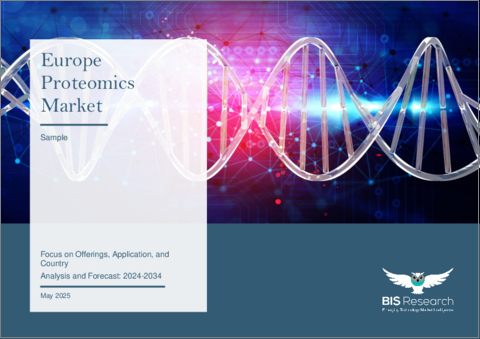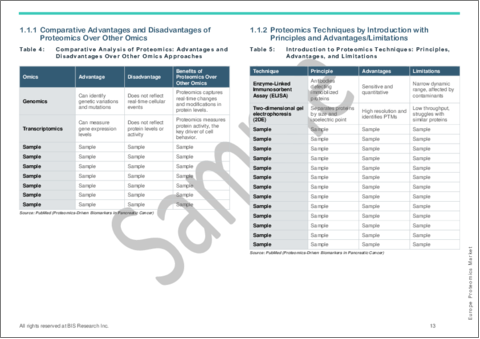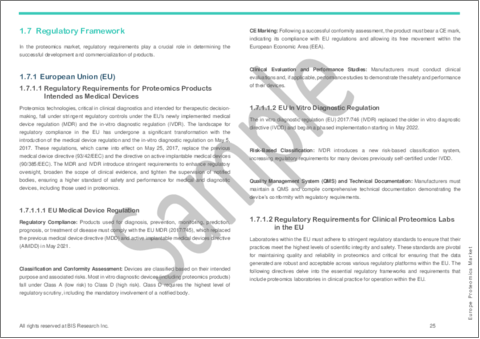|
|
市場調査レポート
商品コード
1732572
欧州のプロテオミクス市場:オファリング別、用途別、国別 - 分析と予測(2024年~2034年)Europe Proteomics Market: Focus on Offerings, Application, and Country - Analysis and Forecast, 2024-2034 |
||||||
カスタマイズ可能
|
|||||||
| 欧州のプロテオミクス市場:オファリング別、用途別、国別 - 分析と予測(2024年~2034年) |
|
出版日: 2025年05月23日
発行: BIS Research
ページ情報: 英文 87 Pages
納期: 1~5営業日
|
全表示
- 概要
- 図表
- 目次
欧州プロテオミクスの市場規模は、2024年の87億7,000万米ドルから2034年には274億3,000万米ドルに達し、予測期間の2024年~2034年のCAGRは12.07%になると予測されています。
質量分析と次世代シーケンシング技術の進歩により、タンパク質分析の精度がますます向上していることが、欧州におけるプロテオミクス市場の成長を牽引しています。さらに、新しいバイオマーカーを発見し、疾患プロファイリングを改善する取り組みに後押しされた個別化医療活動の増加により、需要が拡大しています。新たなプロテオミクス応用は、EUプログラムによる強力な研究資金、官民パートナーシップの拡大、病院、バイオテクノロジー会社、学界間の戦略的提携によって加速しています。一方、欧州の高齢化と慢性疾患の増加は、より優れた診断法と早期発見技術の必要性を浮き彫りにしており、プロテオミクスは同地域の臨床イノベーションとライフサイエンス研究開発環境の重要な構成要素となっています。
市場イントロダクション
| 主要市場統計 | |
|---|---|
| 予測期間 | 2024年~2034年 |
| 2024年の評価額 | 87億7,000万米ドル |
| 2034年の予測 | 274億3,000万米ドル |
| CAGR | 12.07% |
欧州のプロテオミクス市場は、臨床研究機関、製薬会社、ライフサイエンス研究者の多くが、タンパク質レベルの分析が疾病原因の解明、バイオマーカーの発見、医薬品開発のスピードアップにいかに有効であるかを認識し、急成長しています。地域のベンダーやサービスプロバイダーは、高分解能質量分析、マイクロ流体サンプル調製、高度バイオインフォマティクスの継続的な進歩に後押しされ、サンプル入力からデータ解釈までのワークフローを最適化する統合システムを発表しています。発見規模のプロテオミクスと標的プロテオミクスの両方のソリューションに対するニーズは、国家的な研究活動からホライゾン・欧州基金に至るまで、公的および民間資金の流れを通じて、腫瘍学、免疫学、神経変性におけるトランスレーショナル・プロジェクトが加速していることに後押しされています。
最先端のシングルセル・プロテオミクス技術や空間プロテオミクス技術へのアクセスを向上させることにより、産学連携やコンソーシアムによって、研究者は組織微小環境内の細胞の不均一性をマッピングし、新たな治療標的を特定することが可能となっています。臨床検査室は、コンパニオン診断や患者層別化のための複数の反応モニタリングアッセイやラベルフリー定量法を徐々に検証することで、より広範な規制当局の承認や償還のための基礎を築いています。中核施設やデータ解析スキルへのインフラ投資により、プロテオミクスは、西欧、北欧、そして台頭する東欧のハブにおいて、個別化医療や精密医療計画の重要な要素として確固たる地位を築きつつあります。
将来的には、プロトコルのさらなる標準化、マルチオミクス・データ・ストリーム間の相互運用性の向上、クラウド・コンピューティング・プロバイダーとの協力関係の拡大により、参入障壁が低下し、ワクチン開発、バイオマーカー検証、リアルタイムの治療効果モニタリングに新たな道が開けると市場関係者は期待しています。
欧州プロテオミクス市場動向と促進要因・課題
動向
- 高分解能質量分析計とシングルセルおよび空間プロテオミクスワークフローとの統合の拡大
- プロテオミクスとゲノミクスおよびメタボロミクスを組み合わせたマルチオミクス・プラットフォームの拡大
- より深いプロテオームカバレッジのためのラベルフリー定量とデータ非依存型取得の採用の増加
- クラウドベースのバイオインフォマティクスとAI主導のデータ解析パイプラインの出現
- 臨床アッセイ開発における標的プロテオミクス(PRM/MRM)の利用の増加
促進要因
- バイオマーカー探索とトランスレーショナルリサーチを支援する強力なEUと国の資金プログラム
- コンパニオン診断薬や層別化された患者ケアを含む精密医療ソリューションへの需要
- 技術検証を加速する産学連携やコンソーシアムの成長
- 医薬品開発における高度な安全性と有効性試験に対する規制上の奨励
- 疾患の早期発見と治療反応のモニタリングの改善に対するプレッシャー
課題
- 最新鋭の装置と専門要員のための高額な設備投資と運用コスト
- 複雑なサンプル調製ワークフローとラボ間のばらつき
- 膨大なプロテオミクスデータセットと統一規格の欠如別データ管理のボトルネック
- プロテオミクスに基づく診断の臨床的妥当性確認と規制の経路が限定的であること
- 強固な品質管理フレームワークと検査室間の再現性研究の必要性
製品/イノベーション戦略:欧州プロテオミクス市場は、製品、用途、国などさまざまなカテゴリーに基づいて広範にセグメント化されています。これにより、読者は、どのセグメントが最大のシェアを占め、どのセグメントが今後数年間で成長する可能性が高いかを明確に把握することができます。
競合戦略:欧州プロテオミクス市場には、製品・サービスポートフォリオを持つ数多くの既存企業が存在します。本調査で分析・プロファイリングした欧州プロテオミクス市場の主要企業プロファイルには、プロテオミクス製品とサービスを提供する既存企業が含まれています。
主要市場参入企業と競合情勢
プロファイリングされている企業は、主要な専門家から収集した情報に基づいて選択されており、企業のカバレッジ、タイプポートフォリオ、市場浸透度を分析しています。
当レポートでは、欧州のプロテオミクス市場について調査し、市場の概要とともに、オファリング別、用途別、国別の動向、および市場に参入する企業のプロファイルなどを提供しています。
目次
エグゼクティブサマリー
第1章 市場
- 市場見通し
- 主な調査結果
- 欧州プロテオミクス市場のシナリオ
- 業界見通し
- サプライチェーンの概要
- 動向:現状と将来への影響評価
- エンドツーエンドのプロテオミクスワークフローの自動化の推進
- 市場参入企業間の多数のコラボレーション
- 疾患バイオマーカーを特定するためのプロテオミクス調査の拡大
- 特許分析
- 特許出願動向(国別、年別)
- 規制の枠組み
- 欧州連合(EU)
- 製品ベンチマーク
- 市場力学の概要
- 市場促進要因
- 市場抑制要因
- 市場機会
第2章 プロテオミクス市場(地域別)、100万米ドル、2022年~2034年
- 地域のサマリー
- 欧州
- 地域概要
- 市場成長促進要因
- 市場成長抑制要因
- 欧州のプロテオミクス市場(用途別)
- 欧州のプロテオミクス市場(オファリング別)
- フランス
- イタリア
- ドイツ
- 英国
- スペイン
- その他
第3章 市場-競合ベンチマーキングと企業プロファイル
- プロテオミクス市場:競合情勢
- 企業戦略2022年1月~2024年12月
- パートナーシップ、アライアンス、事業拡大
- 合併と買収
- 新しいサービス
- 企業プロファイル
- Biognosys AG
- DiaSorin S.p.A.
- Merck KGaA
- Oxford Expression Technologies Ltd.
第4章 調査手法
List of Figures
- Figure 1: Europe Proteomics Market (by Application), $Billion, 2022, 2027, and 2034
- Figure 2: Europe Proteomics Market (by Product), $Billion, 2022, 2027, and 2034
- Figure 3: Key Events to Keep Track of within the Proteomics Market
- Figure 4: Europe Proteomics Market Size, $Billion, 2022-2034
- Figure 5: Proteomics Literature Published (January 2015 to December 2024)
- Figure 6: Europe Proteomics Market Size and Growth Potential (Realistic Scenario), $Billion, 2022-2034
- Figure 7: Europe Proteomics Market Size and Growth Potential (Optimistic Scenario), $Billion, 2022 to 2034
- Figure 8: Europe Proteomics Market Size and Growth Potential (Pessimistic Scenario), $Billion, 2022 to 2034
- Figure 9: Supply Chain and Risks within the Supply Chain
- Figure 10: Key Features of End-to-End Proteomics Workflow
- Figure 11: Proteomics Market, Patent Analysis (by Country), January 2021-December 2024
- Figure 12: Proteomics Market, Patent Analysis (by Year), January 2021-December 2024
- Figure 13: Proteomics Market, Product Benchmarking (by Product)
- Figure 14: Impact Analysis of Market Navigating Factors, 2024-2034
- Figure 15: Timeline on the Personalized Medicine Journey of Protein
- Figure 16: Difficulties Faced in Top-Down Proteomics
- Figure 17: Future Outlook of Nanoproteomics
- Figure 18: Europe Proteomics Market, $Billion, 2022-2034
- Figure 19: Proteomics Literature Published in Canada (January 2015 to December 2024)
- Figure 20: France Proteomics Market, $Billion, 2022-2034
- Figure 21: Proteomics Literature Published in Italy (January 2015 to December 2024)
- Figure 22: Italy Proteomics Market, $Billion, 2022-2034
- Figure 23: Proteomics Literature Published in Germany (January 2015 to December 2024)
- Figure 24: Germany Proteomics Market, $Billion, 2022-2034
- Figure 25: Proteomics Literature Published in the U.K. (January 2015 to December 2024)
- Figure 26: U.K. Proteomics Market, $Billion, 2022-2034
- Figure 27: Proteomics Literature Published in Spain (January 2015 to December 2024)
- Figure 28: Spain Proteomics Market, $Billion, 2022-2034
- Figure 29: Rest-of-Europe Proteomics Market, $Billion, 2022-2034
- Figure 30: Corporate Strategies, January 2022-December 2024
- Figure 31: Acquisitions (by Company), January 2022-December 2024
- Figure 32: New Offerings Share (by Company), January 2022-December 2024
- Figure 33: Data Triangulation
- Figure 34: Top-Down and Bottom-Up Approach
- Figure 35: Assumptions and Limitations
List of Tables
- Table 1: Market Snapshot
- Table 2: Opportunities across Regions
- Table 3: The Diversified Exposure of Proteomics
- Table 4: Comparative Analysis of Proteomics: Advantages and Disadvantages Over Other Omics Approaches
- Table 5: Introduction to Proteomics Techniques: Principles, Advantages, and Limitations
- Table 6: Comparison of Existing and Emerging Paradigms in Proteomics Technologies
- Table 7: Proteomics Market Trend Analysis
- Table 8: Some of the Partnerships and Collaborations in the Proteomics Market
- Table 9: List of Molecular Targets Identified with Proteomics
- Table 10: Cancer Cases Expected Between 2020 and 2040
- Table 11: Proteomics Market, Regulatory Approvals, and New Offerings
- Table 12: Cancer Biomarkers Discovered by Proteomics and its Applications in Personalized Medicine
- Table 13: Proteomics Market (by Region), $Billion, 2022-2034
- Table 14: Europe Proteomics Market (by Application), $Billion, 2022-2034
- Table 15: Europe Proteomics Market (by Offering), $Billion, 2022-2034
- Table 16: Europe Proteomics Market (by Product), $Billion, 2022-2034
- Table 17: France Proteomics Market (by Application), $Billion, 2022-2034
- Table 18: France Proteomics Market (by Offering), $Billion, 2022-2034
- Table 19: France Proteomics Market (by Product), $Billion, 2022-2034
- Table 20: Italy Proteomics Market (by Application), $Billion, 2022-2034
- Table 21: Italy Proteomics Market (by Offering), $Billion, 2022-2034
- Table 22: Italy Proteomics Market (by Product), $Billion, 2022-2034
- Table 23: Germany Proteomics Market (by Application), $Billion, 2022-2034
- Table 24: Germany Proteomics Market (by Offering), $Billion, 2022-2034
- Table 25: Germany Proteomics Market (by Product), $Billion, 2022-2034
- Table 26: U.K. Proteomics Market (by Application), $Billion, 2022-2034
- Table 27: U.K. Proteomics Market (by Offering), $Billion, 2022-2034
- Table 28: U.K. Proteomics Market (by Product), $Billion, 2022-2034
- Table 29: Spain Proteomics Market (by Application), $Billion, 2022-2034
- Table 30: Spain Proteomics Market (by Offering), $Billion, 2022-2034
- Table 31: Spain Proteomics Market (by Product), $Billion, 2022-2034
- Table 32: Rest-of-Europe Proteomics Market (by Application), $Billion, 2022-2034
- Table 33: Rest-of-Europe Proteomics Market (by Offering), $Billion, 2022-2034
- Table 34: Rest-of-Europe Proteomics Market (by Product), $Billion, 2022-2034
- Table 35: Partnerships, Alliances, and Business Expansions (by Company), January 2022-December 2024
Introduction to Europe Proteomics Market
The Europe proteomics market is projected to reach $27.43 billion by 2034 from $8.77 billion in 2024, growing at a CAGR of 12.07% during the forecast period 2024-2034. Advances in mass spectrometry and next-generation sequencing technologies, which provide ever-increasing precision in protein analysis, are driving the proteomics market's growth in Europe. Demand is further increased by a rise in personalised healthcare activities, which are fuelled by initiatives to find new biomarkers and improve disease profiling. New proteomic applications are being accelerated by strong research funding from EU programs, expanding public-private partnerships, and strategic alliances between hospitals, biotech companies, and academia. In the meantime, Europe's ageing population and increasing prevalence of chronic diseases highlight the need for better diagnostics and early detection techniques, solidifying proteomics as a key component of the region's clinical innovation and life-science R&D environment.
Market Introduction
| KEY MARKET STATISTICS | |
|---|---|
| Forecast Period | 2024 - 2034 |
| 2024 Evaluation | $8.77 Billion |
| 2034 Forecast | $27.43 Billion |
| CAGR | 12.07% |
The market for proteomics in Europe is growing rapidly as more and more clinical labs, pharmaceutical companies, and life science researchers realise how effective protein-level analysis is in understanding disease causes, finding biomarkers, and speeding up drug development. Regional vendors and service providers are launching integrated systems that optimise workflows from sample input to data interpretation, driven by ongoing advancements in high-resolution mass spectrometry, microfluidic sample preparation, and advanced bioinformatics. The need for both discovery-scale and targeted proteomics solutions is being driven by the acceleration of translational projects in oncology, immunology, and neurodegeneration through public and private funding streams, ranging from national research efforts to Horizon Europe funds.
By increasing access to state-of-the-art single-cell and spatial proteomics techniques, academic-industry clinicpartnerships and consortia have made it possible for researchers to map cellular heterogeneity within tissue microenvironments and identify new therapeutic targets. Clinical laboratories are laying the groundwork for wider regulatory approval and reimbursement by progressively validating multiple response monitoring assays and label-free quantification for companion diagnostics and patient stratification. Infrastructure investments in core facilities and data-analysis skills are solidifying proteomics as a key component of personalised and precision medicine plans throughout Western Europe, the Nordics, and rising Eastern European hubs.
In the future, market players expect that further standardisation of protocols, improved interoperability between multi-omics data streams, and expanding collaborations with cloud computing providers will reduce entry barriers and open up new avenues for vaccine development, biomarker validation, and real-time therapeutic efficacy monitoring.
Market Segmentation
Segmentation 1: by Offering
- Product
- Service
Segmentation 2: by Application
- Drug Discovery
- Clinical Diagnostics
- Others
Segmentation 3: by Region
- Europe
- U.K.
- Germany
- France
- Italy
- Spain
- Rest-of-Europe
Europe Proteomics Market Trends, Drivers and Challenges
Trends
- Growing integration of high-resolution mass spectrometers with single-cell and spatial proteomics workflows
- Expansion of multi-omics platforms combining proteomics with genomics and metabolomics
- Increased adoption of label-free quantitation and data-independent acquisition for deeper proteome coverage
- Emergence of cloud-based bioinformatics and AI-driven data analysis pipelines
- Rising use of targeted proteomics (PRM/MRM) in clinical assay development
Drivers
- Strong EU and national funding programmes supporting biomarker discovery and translational research
- Demand for precision medicine solutions, including companion diagnostics and stratified patient care
- Growth of academic-industry partnerships and consortia accelerating technology validation
- Regulatory encouragement for advanced safety and efficacy testing in drug development
- Pressure to improve early-stage disease detection and monitor therapeutic responses
Challenges
- High capital and operational costs for state-of-the-art instrumentation and specialized personnel
- Complex sample preparation workflows and variability across laboratories
- Data management bottlenecks due to massive proteomic datasets and lack of harmonized standards
- Limited clinical validation and regulatory pathways for proteomics-based diagnostics
- Need for robust quality-control frameworks and inter-laboratory reproducibility studies
How can this report add value to an organization?
Product/Innovation Strategy: The Europe proteomics market has been extensively segmented based on various categories, such as offering, application, and country. This can help readers get a clear overview of which segments account for the largest share and which ones are well-positioned to grow in the coming years.
Competitive Strategy: The Europe proteomics market has numerous established players with product and service portfolios. Key players in the Europe proteomics market analyzed and profiled in the study involve established players offering proteomics products and services.
Key Market Players and Competition Synopsis
The companies that are profiled have been selected based on inputs gathered from primary experts and analyzing company coverage, type portfolio, and market penetration.
Some prominent names in the Europe proteomics market include:
- Biognosys AG
- DiaSorin S.p.A.
- Merck KGaA
Table of Contents
Executive Summary
Scope and Definition
1 Market
- 1.1 Market Outlook
- 1.1.1 Comparative Advantages and Disadvantages of Proteomics Over Other Omics
- 1.1.2 Proteomics Techniques by Introduction with Principles and Advantages/Limitations
- 1.2 Key Findings
- 1.3 Europe Proteomics Market Scenario
- 1.3.1 Realistic Scenario
- 1.3.2 Optimistic Scenario
- 1.3.3 Pessimistic Scenario
- 1.4 Industry Outlook
- 1.4.1 Supply Chain Overview
- 1.5 Trends: Current and Future Impact Assessment
- 1.5.1 Increasing Automation for End-to-End Proteomics Workflow
- 1.5.2 Significant Number of Collaborations among Market Players
- 1.5.3 Growing Proteomics Research to Identify Disease Biomarkers
- 1.6 Patent Analysis
- 1.6.1 Patent Filing Trend (by Country, Year)
- 1.7 Regulatory Framework
- 1.7.1 European Union (EU)
- 1.7.1.1 Regulatory Requirements for Proteomics Products Intended as Medical Devices
- 1.7.1.1.1 EU Medical Device Regulation
- 1.7.1.1.2 EU In Vitro Diagnostic Regulation
- 1.7.1.2 Regulatory Requirements for Clinical Proteomics Labs in the EU
- 1.7.1.1 Regulatory Requirements for Proteomics Products Intended as Medical Devices
- 1.7.1 European Union (EU)
- 1.8 Product Benchmarking
- 1.9 Market Dynamics Overview
- 1.9.1 Market Drivers
- 1.9.1.1 Increasing Prevalence of Chronic Diseases
- 1.9.1.2 Increasing Technological Advancements
- 1.9.1.3 Advancements in Personalized Medicine and Drug Discovery
- 1.9.2 Market Restraints
- 1.9.2.1 Shortage of Skilled Professionals
- 1.9.2.2 Complexity in Analyzing Data of Proteomics Research
- 1.9.3 Market Opportunities
- 1.9.3.1 Progress in Nanoproteomics Platforms to Enhance and Thoroughly Analyze Natural Protein Complexes
- 1.9.1 Market Drivers
2 Proteomics Market (by Region), $Million, 2022-2034
- 2.1 Regional Summary
- 2.2 Europe
- 2.2.1 Regional Overview
- 2.2.2 Driving Factors for Market Growth
- 2.2.3 Factors Challenging the Market
- 2.2.4 Europe Proteomics Market, by Application
- 2.2.5 Europe Proteomics Market, by Offering
- 2.2.5.1 Europe Proteomics Market, by Product
- 2.2.6 France
- 2.2.6.1 France Proteomics Market, by Application
- 2.2.6.2 France Proteomics Market, by Offering
- 2.2.6.2.1 France Proteomics Market, by Product
- 2.2.7 Italy
- 2.2.7.1 Italy Proteomics Market, by Application
- 2.2.7.2 Italy Proteomics Market, by Offering
- 2.2.7.2.1 Italy Proteomics Market, by Product
- 2.2.8 Germany
- 2.2.8.1 Germany Proteomics Market, by Application
- 2.2.8.2 Germany Proteomics Market, by Offering
- 2.2.8.2.1 Germany Proteomics Market, by Product
- 2.2.9 U.K.
- 2.2.9.1 U.K. Proteomics Market, by Application
- 2.2.9.2 U.K. Proteomics Market, by Offering
- 2.2.9.2.1 U.K. Proteomics Market, by Product
- 2.2.10 Spain
- 2.2.10.1 Spain Proteomics Market, by Application
- 2.2.10.2 Spain Proteomics Market, by Offering
- 2.2.10.2.1 Spain Proteomics Market, by Product
- 2.2.11 Rest-of-Europe
- 2.2.11.1 Rest-of-Europe Proteomics Market, by Application
- 2.2.11.2 Rest-of-Europe Proteomics Market, by Offering
- 2.2.11.2.1 Rest-of-Europe Proteomics Market, by Product
3 Markets - Competitive Benchmarking & Company Profiles
- 3.1 Proteomics Market: Competitive Landscape
- 3.1.1 Corporate Strategies, January 2022-December 2024
- 3.1.2 Partnerships, Alliances, and Business Expansions
- 3.1.3 Mergers and Acquisitions
- 3.1.4 New Offerings
- 3.2 Company Profiles
- 3.2.1 Biognosys AG
- 3.2.1.1 Overview
- 3.2.1.2 Top Products/ Services
- 3.2.1.3 Top Competitors
- 3.2.1.4 Target Customers
- 3.2.1.5 Key Personnel
- 3.2.1.6 Analyst View
- 3.2.2 DiaSorin S.p.A.
- 3.2.2.1 Overview
- 3.2.2.2 Top Products/ Services
- 3.2.2.3 Top Competitors
- 3.2.2.4 Target Customers
- 3.2.2.5 Key Personnel
- 3.2.2.6 Analyst View
- 3.2.3 Merck KGaA
- 3.2.3.1 Overview
- 3.2.3.2 Top Products/ Services
- 3.2.3.3 Top Competitors
- 3.2.3.4 Target Customers
- 3.2.3.5 Key Personnel
- 3.2.3.6 Analyst View
- 3.2.4 Oxford Expression Technologies Ltd.
- 3.2.4.1 Overview
- 3.2.4.2 Top Products/ Services
- 3.2.4.3 Top Competitors
- 3.2.4.4 Target Customers
- 3.2.4.5 Key Personnel
- 3.2.4.6 Analyst View
- 3.2.1 Biognosys AG
4 Research Methodology
- 4.1 Data Sources
- 4.1.1 Primary Data Sources
- 4.1.2 Secondary Data Sources
- 4.1.3 Data Triangulation
- 4.2 Market Estimation and Forecast






